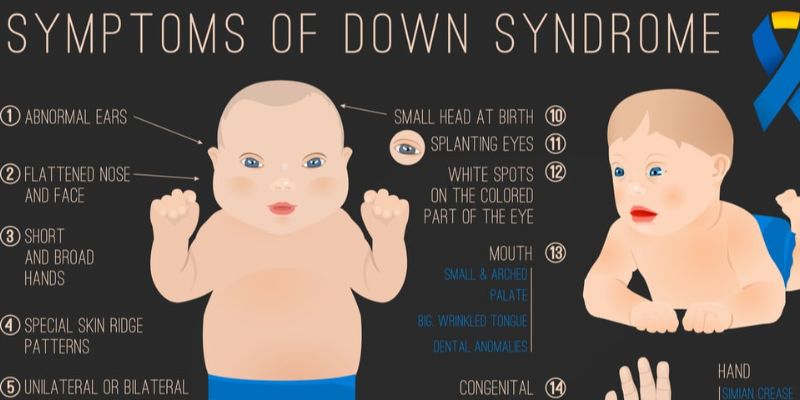Symptoms of Down Syndrome
Jan 30, 2024 By Marie White
Down Syndrome is a genetic disorder caused by an extra chromosome that can cause lifelong physical and mental health challenges. For many born with it, the specific symptoms of Down Syndrome range from mild to severe.
Understanding these symptoms can help families and individuals anticipate the needs of those with Down Syndrome and be better prepared for the journey ahead. Keep reading to learn more about the different characteristics of this chromosomal disorder so you can equip yourself or your loved ones to face any potential obstacles along their path toward successful lives.
Overview

Down Syndrome is a genetic disorder caused by an extra chromosome in each cell, resulting in 47 chromosomes instead of 46. People with Down Syndrome often experience physical and mental health challenges ranging from mild to severe.
A greater understanding of this condition can help families and individuals anticipate the needs of those with Down Syndrome to be better prepared for the journey ahead. Early diagnosis and interventions can significantly improve the quality of life for those with this disorder, allowing them to live fulfilling lives.
Some common physical characteristics of Down Syndrome include low muscle tone, small stature, an upward slant to the eyes, and abnormal folds in the palms of the hands.
Psychological symptoms may include delayed development, slower cognitive abilities, and difficulties with communication. In addition, those with Down Syndrome may be at higher risk for certain medical conditions, such as heart defects and digestive problems.
Proper diagnosis and treatment of these conditions can help manage the symptoms of Down Syndrome and give individuals the best chance of reaching their full potential.
Who Does Down Syndrome Affect
Down syndrome affects anyone, regardless of ethnicity, gender, or socioeconomic status. It is a genetic condition that occurs randomly when an individual has three copies of chromosome 21 instead of two. While most cases occur spontaneously at conception, there is a higher risk for people over 35 to have babies with Down Syndrome.
Risk Factors for Down Syndrome
The risk of having a baby with Down Syndrome increases as the parents age. Women or people assigned female at birth (AFAB) who are 35 or older are more likely to have a child diagnosed with this condition.
While many cases occur spontaneously, studies suggest that individuals over 35 have higher chances of giving birth to a child with Down Syndrome than those younger.
Genetic factors can also increase the risk of Down Syndrome. If there is a history of Down Syndrome in the family, the individual may have a higher chance of having it due to its genetic nature. However, many families are unaffected since most cases occur randomly and not due to inherited genes.
Down Syndrome is the most common chromosome-related condition in the United States. About 6,000 babies are born with Down Syndrome yearly, 1 in every 700 births. In addition to that, there are about 200,000 people diagnosed with this disorder in America.
Apart from the baby's age and genetic factors, experts suggest that certain environmental risks can increase the chance of Down Syndrome. These include obesity, smoking, or exposure to certain chemicals during pregnancy.
Proper detection and diagnosis can play an important role in managing the symptoms of Down Syndrome and allowing individuals with this disorder to reach their full potential. Early diagnosis and interventions are essential for providing better healthcare options and treatment plans to help those affected by Down Syndrome live more fulfilling lives.
The key to helping those with Down Syndrome is understanding the condition and its symptoms and equipping yourself or your loved ones to face any potential obstacles. With proper diagnosis and assistance, individuals can lead successful and productive lives despite the challenges they may face due to this disorder.
Down Syndrome Symptoms

The most common symptoms of Down Syndrome include physical, cognitive, and behavioral symptoms.
Physical signs of Down syndrome
Physical signs of Down Syndrome are often visible at birth and become increasingly apparent as the child grows. They include a host of physical characteristics that set individuals with Down Syndrome apart from their peers, including:
- A flat nose bridge is an identifying characteristic for many with Down Syndrome and may be more pronounced in some than others.
- Slanted eyes that point upward - Individuals with Down Syndrome may have eyes that appear to look upward or are slightly slanted.
- A short neck is another distinguishing feature of individuals with Down Syndrome. Many will have shorter necks than their peers.
- Small ears, hands, and feet - These body parts tend to be smaller than average in those with Down Syndrome.
- Weak muscle tone at birth - Low muscle tone is common in babies born with Down Syndrome and can persist into adulthood.
- The small pinky finger pointing inward towards the thumb - This characteristic often goes unnoticed but can be seen closely.
- One crease in the palm of their hand (palmar crease) - People with Down Syndrome usually have one deep line in their hand rather than two.
- Shorter-than-average height - Individuals with Down Syndrome may be shorter than average and have a different growth pattern than others.
In addition to these visible signs at birth, individuals with Down Syndrome may experience various other physical symptoms as they age. These include ear infections, hearing loss, vision problems, dental problems, and being more prone to infections or illnesses. They may also be at an increased risk for obstructive sleep apnea and congenital heart disease.
Cognitive symptoms of Down syndrome
Cognitive symptoms of Down Syndrome are common due to the extra chromosome in the individual's cells. These can include intellectual and developmental disabilities, making it difficult for individuals with Down Syndrome to reach their full potential.
Common cognitive challenges associated with this disorder include:
- Delays in reaching developmental milestones such as speaking first words or taking first steps
- Difficulty learning and retaining new information
- Trouble understanding or using language
- Difficulties with problem-solving, processing information, and memory recall
- Delayed motor development, including walking and gross motor skills
- Problems with fine motor coordination, such as handwriting and hand-eye coordination
- Social difficulties due to impaired recognition of facial expressions, body language, and social cues
- Difficulty understanding abstract concepts such as time, numbers, and abstract reasoning.
Behavioral symptoms of Down syndrome
Behavioral symptoms of Down Syndrome can range from mild to severe and are often the result of individuals' limited ability to communicate their needs effectively. Common behavioral symptoms associated with this disorder include:
- Stubbornness and tantrums - Individuals with Down Syndrome may have difficulty controlling their emotions, leading to frequent outbursts or tantrums.
- Difficulty paying attention - People with Down Syndrome may have trouble focusing on tasks and sustaining their attention over time, making learning and studying more difficult.
- Obsessive or compulsive behaviors - Individuals with Down Syndrome may exhibit repetitive behaviors such as hand flapping or rocking back and forth, which can be triggered by stress, fear, or excitement.
FAQs
What does mild Down syndrome look like?
Mild Down Syndrome can present very differently from person to person. Generally, individuals with mild Down Syndrome may have fewer physical and cognitive symptoms than those with more severe forms of the disorder. They may also experience less difficulty reaching developmental milestones than those with more severe cases.
How can I best help someone with Down syndrome?
The best way to help someone with Down Syndrome is to understand the disorder and equip yourself or your loved one to be prepared for any challenges they may face. Providing a safe and supportive environment where the individual feels accepted is also important.
Can people with Down Syndrome live long and healthy lives?
Yes! With proper support, care, and access to resources, those with Down Syndrome can lead happy and productive lives. Family involvement and understanding the individual's needs are crucial in helping them reach their full potential.
Conclusion
Down Syndrome is a lifelong genetic disorder affecting individuals in many ways. The key to helping those diagnosed with Down Syndrome is understanding the condition and recognizing its various symptoms. Symptoms include physical signs, cognitive challenges, and behavioral issues. With proper diagnosis and assistance, individuals can lead successful and productive lives despite the challenges they may face due to this disorder. Early intervention is important for these individuals, as it can help them reach their full potential.

Learn How To Get Amazing Skin: 5 Drinks You Can Put Together Yourself

Exploring the Health Benefits of Cashews: Nutrition and Wellness

Best Time to Have Your First Meal: A Guide to Eating After Waking Up

Understanding and Overcoming Anxious Thoughts: Practical Ways to Worry Less

Migraine Relief Through Yoga: What You Need to Know

The Ultimate Guide to Treating Scalp Acne and Folliculitis

What Are The Signs Of A Slowed Heart Rate?


